Founded in 1995 when the internet was in its infancy, Getty Images transformed from an ambitious startup acquiring analog photo archives into a global B2B content platform serving customers in over 22 countries. Through strategic partnerships with tech giants like Apple, Google, and Microsoft, along with integration into platforms like Canva, TikTok, and Squarespace, Getty has maintained its position as an industry leader, while many competitors have disappeared.
“We were pioneers in the industry,” Orlowsky explains. “We had a view about how we could use the internet to scale a business.” Nearly three decades later, that pioneering spirit continues as Getty embraces the AI revolution through responsible, rights-managed approaches to generative content.
In this article, you’ll discover:
- How to identify and structure strategic B2B partnerships that solve real customer problems
- Techniques for creating seamless integration experiences that meet customers where they are
- Methods for developing flexible commercial arrangements that benefit all parties
- Strategies for navigating industry transformations through partnership innovation
Table of contents
- From physical catalogs to digital pioneer: Getty’s content transformation journey
- Building a partnership ecosystem: Meeting customers where they are
- The 4 partnership principles behind Getty’s long-term success
- Real-world partnership examples: Strategic integrations that drive growth
- Navigating the future: How Getty is approaching the AI transformation
- The partnership advantage
- Action steps for building strategic partnerships
From physical catalogs to digital pioneer: Getty’s content transformation journey
Before Getty Images emerged in 1995, the photography industry operated primarily in the analog world — photographers shot on film, developed physical prints, and distributed images through printed catalogs and direct mail. Searching for the perfect image meant flipping through pages or negotiating directly with photographers.
Mark Getty and Jonathan Klein recognized an enormous opportunity: digitizing photography and using the nascent internet to distribute images globally at an impressive scale.
Seeing the digital opportunity
“The industry was an analog industry,” Orlowsky explains. “I think Getty Images saw that as an opportunity to roll it up into a digital industry using the internet. So what they started to do in ‘95 was acquire big archives, like a company called Tony Stone, which is a big stock company.”
This vision was remarkably forward-thinking for the mid-90s, when:
- Most internet users were still connecting via dial-up modems
- Web browsers were in their infancy
- Digital photography was expensive and uncommon
- Few businesses had established an online presence
Building the digital infrastructure
The transformation wasn’t immediate. Initially, Getty used specialized software to digitize and transmit images, but the company quickly pivoted to internet-based distribution as connectivity improved. This technological shift allowed Getty to:
- Distribute images instantly worldwide, rather than shipping physical materials
- Build a searchable database that made finding specific images vastly more efficient
- Scale their operations globally without proportional increases in physical infrastructure
- Adapt to changing customer needs through flexible digital delivery
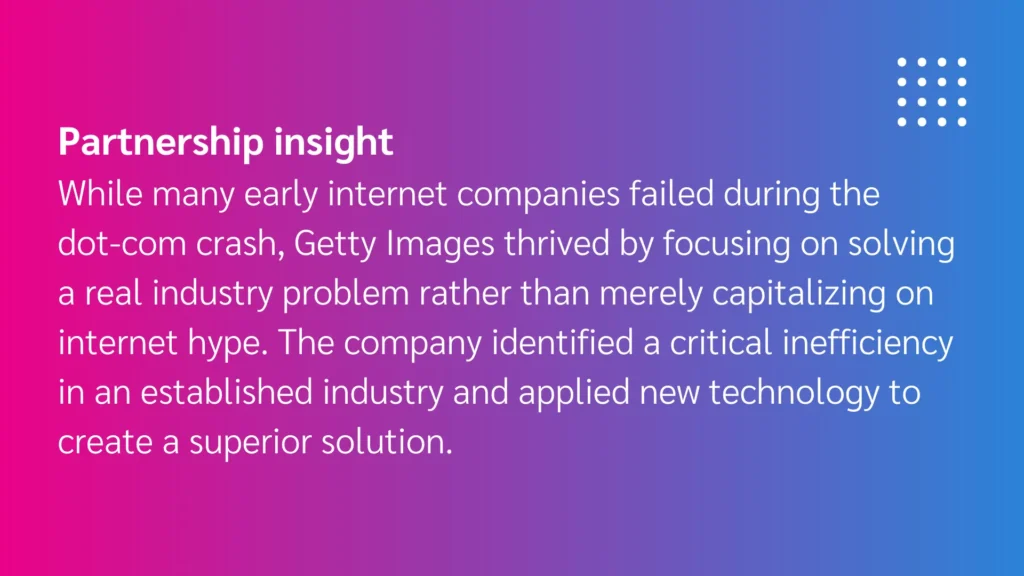
Maintaining market leadership through change
Perhaps most remarkably, Getty Images has maintained its market leadership through multiple technological transformations. “If you look at the space 15 years ago, our competitors, then Corbis and others, they don’t really even exist today,” Orlowsky notes. “That’s been a real legacy of ours and value that we’ve been able to continue to evolve and move with all the new players in the space.”
Today, Getty’s digital transformation continues as the company expands into video, leverages AI technology and connects its vast content library with an increasingly diverse ecosystem of platforms and partners.
Building a partnership ecosystem: Meeting customers where they are
Getty Images’ approach to partnerships has evolved alongside its digital transformation. Rather than viewing their content as something customers should access, Getty has built a robust ecosystem where their imagery is available across the digital ecosystem.
Understanding the platform strategy
Orlowsky distinguishes between two key approaches to serving customers:
“There’s a platform strategy and then there’s an off-platform strategy,” he explains. This insight drives how Getty structures its partnerships.
- Platform strategy: Direct customers who visit Getty Images, iStock, or Unsplash websites to license content
- Off-platform strategy: Integrating Getty content into other services and platforms where customers are already working
This dual approach allows Getty to:
- Serve customers who specifically seek their content
- Reach users who need imagery but primarily use other digital tools
- Create seamless experiences that reduce friction for end users
- Expand their reach through strategic partnerships
Seamless integration: The key to partner success
What makes Getty’s partnerships particularly effective is their focus on creating frictionless experiences for end users. When a customer uses a platform like Canva or TikTok and needs an image, they don’t need to leave that environment.
“Those customers are staying within the platform they’re working for,” Orlowsky notes. “They’re just seamlessly using it based on whatever service they’re paying for.”
This approach delivers multiple benefits:
- For end users: Maintains workflow without disruption
- For partners: Enhances their product offering without sending users elsewhere
- For Getty: Expands content distribution and revenue opportunities
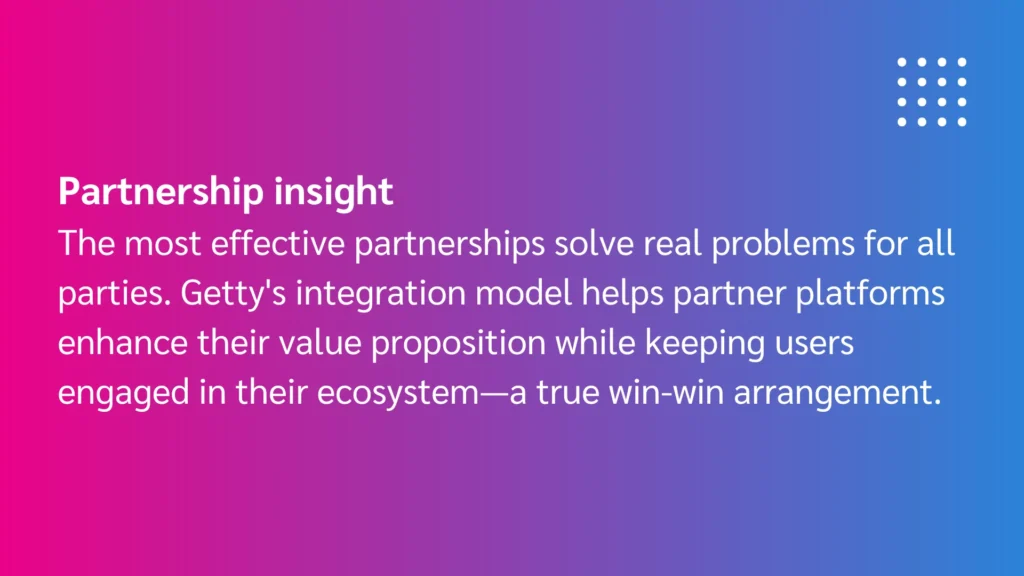
Building the right solution for each partner
Not all partnerships look the same. Getty tailors each relationship based on the specific needs of the partner and their users.
“We might work with multiple different companies in the same space. They’re never the same deal,” Orlowsky emphasizes. “Some people want certain different types of use cases and higher value content. Some people might want to clear rights that they have to go through, and that’s a different thing.”
Key factors that shape these partnerships include:
- Content type requirements (editorial vs. creative)
- Media formats needed (still images, video, or both)
- Required rights clearances and permissions
- Exclusivity considerations
- Pricing and commercial structure preferences
By understanding each partner’s unique needs, Getty can craft solutions that provide genuine value while protecting its own business interests and content creator relationships.
The 4 partnership principles behind Getty’s long-term success
Throughout the conversation with Orlowsky, several consistent principles emerge that have guided Getty Images’ partnership strategy. These principles have enabled the company to maintain leadership through multiple industry transformations.
1. Focus on solving real customer problems
At the core of Getty’s partnership approach is a genuine focus on understanding and addressing partner needs rather than simply selling a product.
“If you go in and just try to sell something to make money, you’re going to fail,” Orlowsky states emphatically. “If you’re genuinely not in there thinking about what the customer’s really trying to do and really doing the research around how you can really benefit them, then the likelihood is the partnership’s not going to work out.”
This customer-first mindset requires:
- Conducting thorough discovery to understand partners’ business challenges
- Researching their customers and use cases
- Identifying how Getty can add genuine value to their offerings
- Finding solutions that enhance rather than compete with their core services
2. Create flexible commercial structures
Getty avoids one-size-fits-all approaches to partnership agreements, instead tailoring commercial terms to match each partner’s business model and goals.
“On the commercial side, I think we do things a couple different ways, and what I will share is it’s sort of what works,” explains Orlowsky. The company embraces several models:
- Fixed licensing fees: For partners who want predictable costs
- Revenue sharing: For growth-oriented partnerships where both parties benefit from success
- Hybrid approaches: Combining elements to create the right structure for each situation
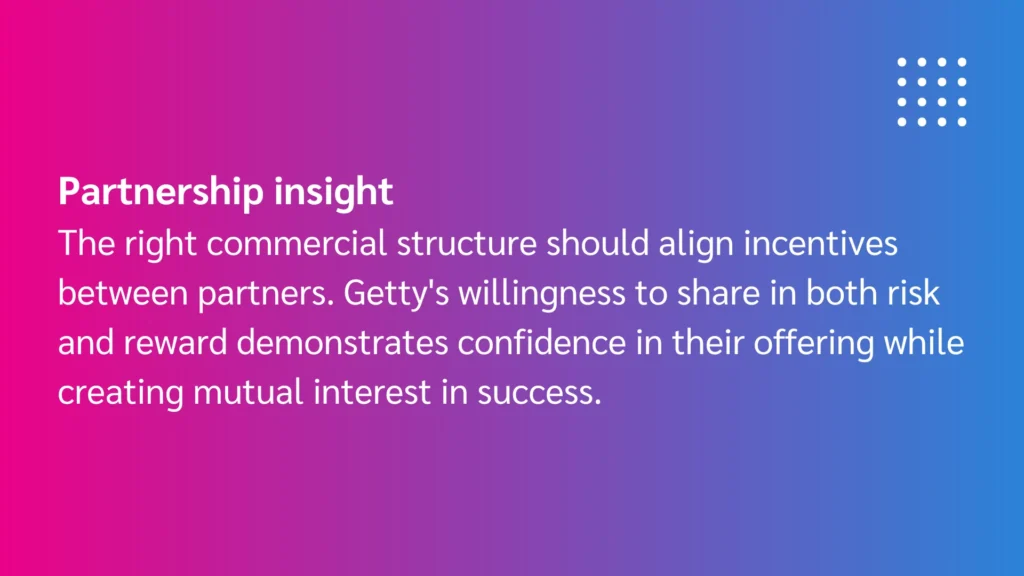
3. Build for long-term evolution
Getty recognizes that partnerships are living relationships that evolve over time, not static agreements.
“Just when you start that deal, that’s really just the beginning of it,” Orlowsky observes. “It’s never really where, ‘Hey, we did this. Let’s go on and find the next one.’ It’s really about where are you going to go from there, and how are you going to continue to help both parties build and work on that?”
This long-term perspective involves:
- Regular reassessment of partnership performance and needs
- Willingness to adapt as business conditions change
- Viewing initial agreements as starting points, not final destinations
- Investing in relationship development, not just transaction completion
4. Differentiate through quality and trust
Getty maintains its value proposition in a crowded content marketplace through an unwavering commitment to quality, rights management, and risk mitigation.
“How do we mitigate their risk?” Orlowsky asks rhetorically. “How do we make sure that they know that when they come to us for content, that they’re going to be covered off, that what we give them they’ll be safe with, they’ll be responsible, and they won’t have to worry about that.”
This focus on quality and safety includes:
- Providing proper licensing and rights clearance
- Ensuring content authenticity and ownership
- Offering indemnification for partners
- Maintaining content quality standards across partnerships
- Creating different tiers of content to match different partner needs
By maintaining these standards while being flexible on implementation, Getty creates partnerships that deliver genuine value while protecting its brand integrity and partner relationships.
Real-world partnership examples: Strategic integrations that drive growth
Getty’s partnership approach comes to life through concrete examples that demonstrate how these principles work in practice. These case studies illustrate the diverse ways Getty integrates its content into partner ecosystems.
The creative platform integration: Canva
One of Getty’s most visible partnerships is with Canva, a design platform where millions of users create everything from social media graphics to presentations and marketing materials.
“All everybody that’s going to Canva to use their tools and services—Getty is a really close partner,” Orlowsky explains. “Where you’re going in and accessing our tools, our content to be a part of that.”
This integration works through several key mechanisms:
- Getty’s API connects directly to Canva’s platform
- Users search for images without leaving their design workflow
- Getty’s search technology powers relevant content discovery
- Licensing happens seamlessly within Canva’s interface
- Users never need to manage separate Getty accounts
The result is a partnership that enhances Canva’s value proposition while expanding Getty’s reach to millions of creators who might never visit Getty’s own platforms directly.
The advertising ecosystem: TikTok
A more recent partnership showcases Getty’s adaptation to emerging platforms. By integrating with TikTok’s advertising tools, Getty helps businesses create more effective ad content.
“Most recently, we just announced a deal with TikTok where, if you’re a partner of TikTok and you want to go in and create an ad inside of there and you’re using their toolset, but you need a piece of content that could help you talk about business people or families having fun on the beach, you can access an image connected as part of that.”
This partnership demonstrates Getty’s ability to:
- Adapt to new content formats and platforms
- Support emerging advertising ecosystems
- Provide contextually relevant imagery for specific use cases
- Streamline creative workflows for advertisers
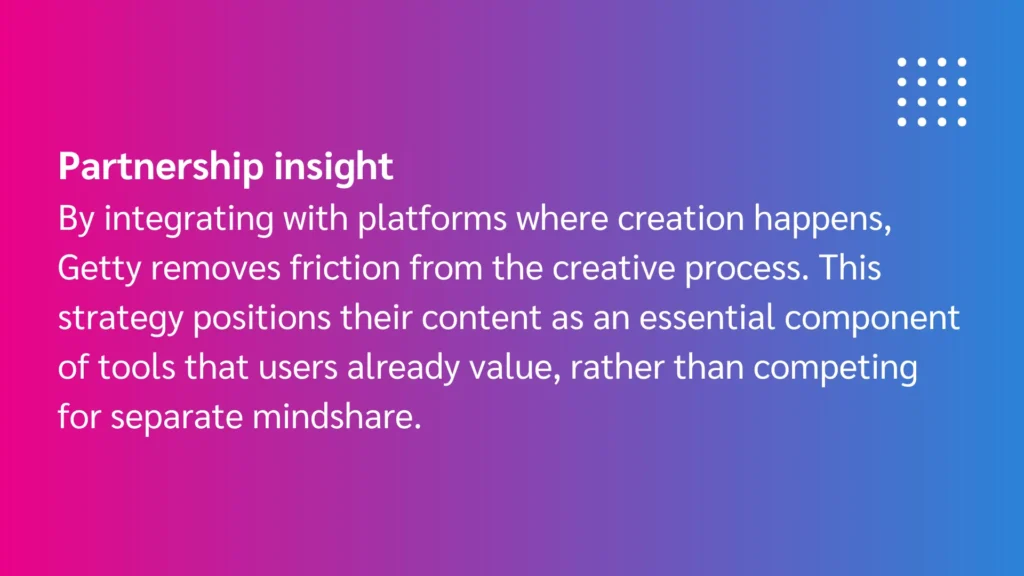
The website builder: Squarespace
Getty’s partnership with Squarespace exemplifies how content integration can enhance core services while creating upsell opportunities.
“People will go there because they want to build websites or they want to use other services to help promote their business,” Orlowsky explains. “Squarespace is really great at what they do […] but they don’t really necessarily have access to a repository of imagery that is high quality as we do.”
This partnership creates multiple benefits:
- For Squarespace: Enhanced website creation experience for users
- For website creators: Access to professional-quality imagery within their workflow
- For Getty: Distribution to a targeted audience of content creators
- For both partners: Opportunity for tiered offerings and premium upsells
“Sometimes they might want to give away a basic package, and they give part of our collection in there, and then they want to upsell them to be in a position to charge them more money for a premium account,” Orlowsky notes. “We can help them use levers of giving them different access to content.”
Creator partnerships: iStock’s affiliate program expansion
Getty’s partnership approach extends beyond technology platforms to include creators and influencers. In early 2024, iStock (part of Getty Images’ family of companies) launched a campaign to promote its new Generative AI product by expanding its affiliate program to include micro and mid-tier creators.
Working with a managed services partner, iStock recruited creators like @premiere_gal, @nomadatoast, and @theclarkgary to create educational content showcasing the AI tool’s capabilities. These creators produced Instagram Reels, TikTok videos, and Instagram Stories that demonstrated how iStock’s AI tools could help users modify stock images or create unique AI-generated images for commercial use.
The campaign generated over 15 million impressions and drove significant traffic and conversions, while establishing valuable creator relationships that would enable future program scaling. This example demonstrates Getty’s ability to adapt its partnership approach to emerging platforms and audiences while maintaining its focus on quality, rights management, and user education.
Beyond integration: The expanding partnership ecosystem
Getty’s partnership approach extends beyond these examples to create an interconnected ecosystem. As Orlowsky points out, many of Getty’s partners also partner with each other, creating layered relationships:
“We have those conversations all the time with the HubSpots and the constant contacts. Sometimes it does get to that point where a lot of players we’re working with are integrated in some ways or form.”
This network effect amplifies Getty’s reach, as its content becomes accessible through multiple entry points across the digital landscape. A user might access Getty content through HubSpot via Canva, creating a seamless experience that serves the user while benefiting all partners in the chain.
By creating these strategic integrations, Getty transforms from a standalone content destination into an essential component of the broader creative ecosystem—a strategy that has fueled its continued growth and relevance in an increasingly competitive marketplace.
Navigating the future: How Getty is approaching the AI transformation
Just as Getty Images pioneered the digital transformation of photography in the 1990s, the company now faces another revolution: artificial intelligence and generative content. The parallels aren’t lost on Orlowsky.
“I remember saying like, you know, this is so great. We get to do something no one’s ever done before. You know, I’m probably never going to be able to be involved in something like this again. And here we are. Right? Like it’s happening again.”
Embracing responsible AI innovation
While some content companies have positioned themselves against AI advancement, Getty has taken a proactive approach, developing strategic partnerships that enable innovation while protecting creators’ rights.
“The hot item and the big thing is AI,” Orlowsky acknowledges. “We took a really strong position that we were going to do it the right way.”
This “right way” involves several key components:
- Partnering with technology leaders like Nvidia and Picasso
- Creating tools that ensure the responsible use of generative AI
- Protecting intellectual property rights
- Ensuring creators are compensated fairly
- Providing safe, identifiable content for brands
“We use our library to basically go out and create tools and services that are responsible, that are safe, that we can identify and can really help brands so they don’t have to worry about… are they doing the right thing?” Orlowsky explains.
Data licensing: The next frontier
Beyond image licensing, Getty has identified data licensing as a significant growth opportunity in the AI era.
“Data licensing has become a really, really huge part of our industry,” Orlowsky notes. “There are a lot of companies out there that are trying to train models to do different things.”
This evolution represents a fundamental shift in how Getty’s assets create value:
- Companies need high-quality data to train AI models
- Getty’s carefully curated content provides clean, rights-cleared training data
- The associated metadata enhances model understanding and capabilities
- Getty’s verification and rights management reduces the risk for AI developers
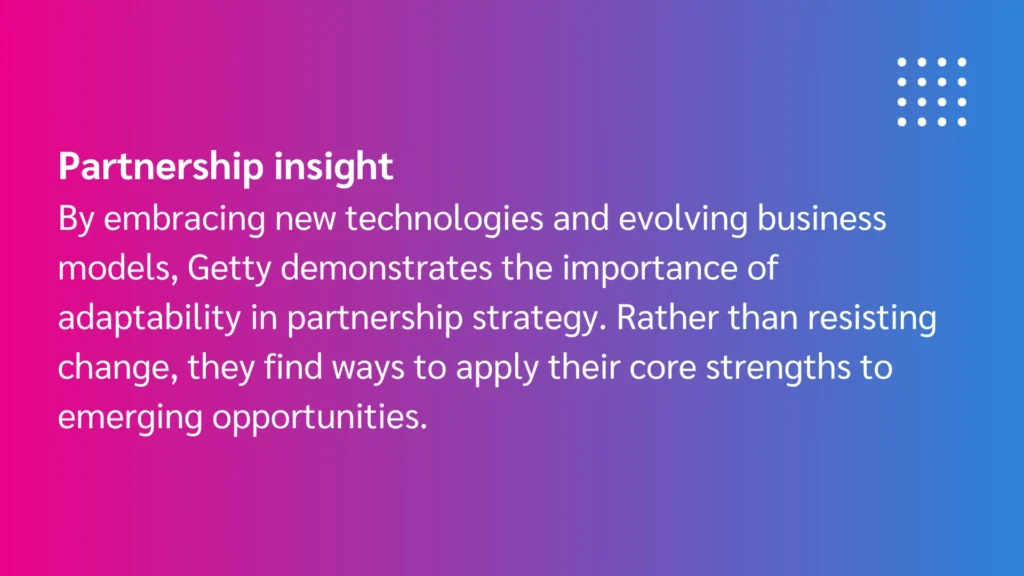
The growth trajectory
The potential scale of this opportunity is enormous. As Orlowsky shares, “Currently they’re saying it’s about a 2.5 billion dollar space today. But they’re saying within the end of a decade it’ll be about a 20 billion dollar space.”
This growth forecast represents a fundamental expansion of how Getty’s content creates value:
- Traditional licensing: Content used directly in creative works
- Platform integration: Content available within creative tools
- Data licensing: Content and metadata used to train AI systems
- Future innovations: New applications not yet envisioned
Lessons for partnership professionals
Getty’s approach to AI and data licensing offers valuable lessons for partnership professionals across industries:
- Embrace change: View industry transformations as opportunities, not threats
- Apply core strengths to new contexts: Identify how your fundamental value can adapt
- Research emerging trends: Invest time understanding where industries are heading
- Build relationships early: Engage with innovative companies before full maturity
- Balance innovation with responsibility: Maintain core values while exploring new frontiers
“You just gotta be fearless, right? And figure it out,” Orlowsky advises. “This is coming fast and I gotta figure this out. But, you know, once you do, you could see where it’s going.”
The partnership advantage
Throughout its nearly 30-year history, Getty Images has demonstrated that strategic partnerships are not merely a growth tactic but a fundamental business strategy that enables adaptation, innovation, and market leadership.
By focusing on solving real customer problems, creating seamless experiences, developing flexible commercial arrangements, and maintaining quality standards, Getty has built an ecosystem that extends far beyond its own platforms.
As Orlowsky reflects, “For us being able to keep up with that change over the time periods is the reason we’re still around today.” In a business landscape defined by constant transformation, this ability to evolve through strategic partnerships may be Getty’s most valuable lesson for companies in any industry.
Action steps for building strategic partnerships
Based on Getty Images’ successful partnership approach, here are key steps you can take to develop your own effective partnership strategy:
- Identify real customer problems your partnerships can solve
- Research potential partners’ business challenges and customer needs
- Focus on how your capabilities can add genuine value to their offerings
- Prioritize partnerships that enhance rather than compete with core services
- Create seamless integration experiences
- Meet customers where they already are instead of forcing them to your platform
- Design integrations that maintain workflow continuity for end users
- Ensure your technology (APIs, tracking, authentication) supports frictionless experiences
- Develop flexible commercial structures
- Tailor partnership terms to each partner’s business model and goals
- Consider multiple approaches: fixed licensing, revenue sharing, or hybrid models
- Align incentives to create mutual interest in long-term success
- Build for continuous evolution
- View partnerships as ongoing relationships, not static agreements
- Regularly reassess performance and adapt as business conditions change
- Invest in relationship development beyond initial implementation
- Differentiate through quality and trust
- Clearly articulate your unique value proposition to potential partners
- Address risk mitigation as a key benefit of partnership
- Maintain consistent quality standards across all partnership implementations
- Explore diverse partnership types
- Look beyond technology platforms to include creators, agencies, and specialists
- Test different partnership models to discover what works best for your business
- Measure results carefully to identify your most effective partnership formats
- Embrace industry transformations
- Research emerging trends that may affect your industry
- Identify how your core strengths can apply to new technologies and platforms
- Build relationships with innovative companies before your competitors do
Whether you’re navigating digital transformation, exploring AI opportunities, or simply looking to expand your market reach, Getty’s partnership principles offer a proven framework for sustainable growth and continued relevance in an ever-changing world.
Browse our recommended resources for additional insights, strategies and tips:
- iStock by Getty Images expands its affiliate program to creators and gains 15m+ impressions (case study)
- The power of AI-driven affiliate marketing: Button and impact.com integration (blog)
- How to build a successful B2B affiliate marketing program: Tips from industry experts (blog)
- How creators use AI to increase brand awareness and audience reach (blog)
- 4 types of B2B affiliate-based partnerships [+brands winning in each category] (blog)
- How AI, automation, and authenticity are changing influencer marketing with impact.com’s CMO, Cristy Garcia (blog)
- 3 ways Google’s new AI Overview feature can affect product review sites (blog)







